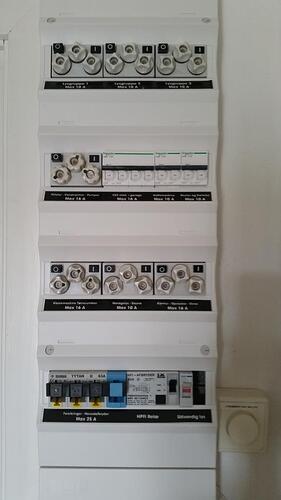Hello Robert
**
Measurement of 3 phase power as in most of Europe
**
Sorry for my late reply, but I just had to think about your comprehensive writing and some possible solutions.
Yes, I have an electrician background so my insight into Danish conditions is great.
I’ve been thinking a lot about how it can be best to handle a 3-phase installation with existing equipment, or maybe existing equipment with small adjustments.
DIN Rail
In Denmark, we have used “DIN rail” since approx. 1970, so it is very common here. Therefore, it makes sense to use DIN mounted components in both private households and in industry. When looking at European trade pages, it seems that “DIN rail” is used in most of Europe today, as the standard of safety equipment is based on “DIN rail”
Have looked at 3 phase systems in Europe and, as I see it, 4 Wire solutions are used throughout Europe. Also in Norway. The main reason for this is that the 4th Wire is neutral, and most often connected to Earth from the EL supplier. It is the basis for being able to use an HPFI relay, as personal protection.
See my link here:
http://www.dii.unipd.it/-renato.gobbo/download/schneider/schneider_173.pdf
As I see it, there are 3 phases + neutral + earth, the predominant standard in the largest part of Europe, but you are right in that in France, Belgium and Norway are some older 3 Wire systems yet. But new installations are 3 phases + N + Earth in star clutch.
Households in Norway have 230V single phase (IT-N), 230V three-phase (IT-N) or 400V three-phase (TN-S) wiring, the latter only used in new areas.
Proposal for a solution
AC adapter for “DIN rail”
With the shown AC adapter for DIN mounting, it makes sense if the emonTx V3 had 3 AC input so that 3 phase systems could be handled in this way and calculate REAL POWER. Thus, approval issues are also resolved.
There is no need for a USB plug when it is in a power panel, so it will be easier with a 3x voltage input terminal and it will also fill less. I think there should be a solution that can be used both single-phase and 3-phase privately, and 3-phase for “DIN Rail” assembly. (Housholds and Industry)
If you want a cheap 3-phase installation in your home, you can solve this by allowing an electrician to install 3 single 230V sockets, at each phase, from a 3-phase circuit breaker. Here you can then install 3 x 9V AC adapters that are also used today.
Market:
The UK is special in this area, as many older installations are based on 1 phase solutions.
But in most of Europe today, there are 3 phase solutions that prevail. Therefore, I think there will be a big market for this particular solution.
The current solutions with 3 x emonTx3 + emonPi will be unnecessarily complex to install, and I think I’m dissuasive. Also myself.
Development
Could Glyn be persuaded to take it into consideration in emonTx V4?
Danish house installation anno 1976
Here is my house installation done in 1976 where everything is made as “DIN rail” assembly.
In 1976, it was normal to use a 3-phase group switch for 3 light groups. However, it is a dangerous solution if the Neutral cord fails, as some devices will be exposed to 400 V. I plan to change this soon.
